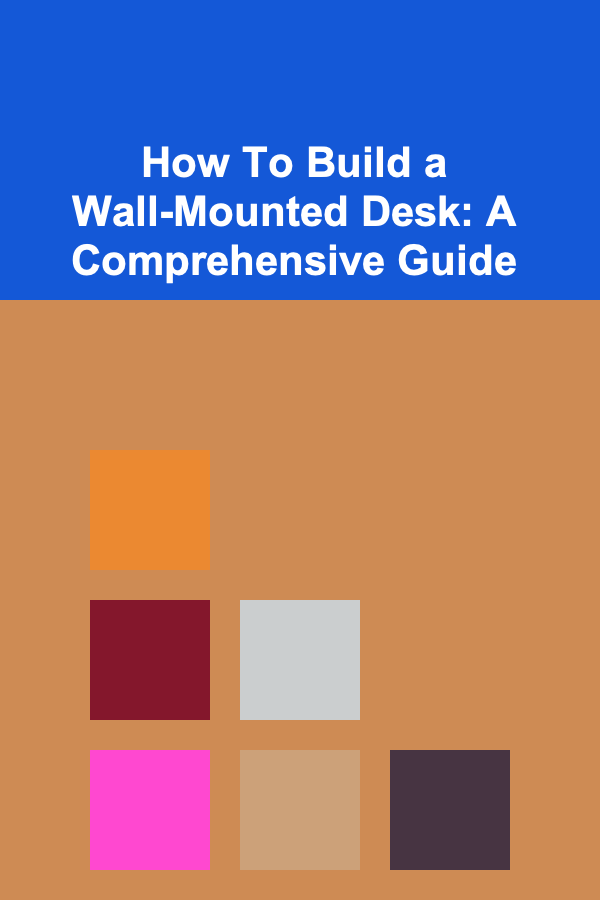
How To Build a Wall-Mounted Desk: A Comprehensive Guide
ebook include PDF & Audio bundle (Micro Guide)
$12.99$9.99
Limited Time Offer! Order within the next:

Building a wall-mounted desk is an excellent way to save space and create a sleek, modern workspace. Whether you're looking to optimize a small room, add functionality to a home office, or create a minimalist aesthetic, a wall-mounted desk can be both practical and stylish. This comprehensive guide will take you through the entire process, from planning and measuring to assembling and mounting, with detailed instructions and helpful tips along the way.
Planning Your Wall-Mounted Desk
Before you start gathering materials and tools, it's crucial to plan your wall-mounted desk carefully. This stage sets the foundation for the rest of the project, ensuring that the desk will meet your needs and fit perfectly into your space.
1.1 Choose the Right Location
The first step is determining the best location for your desk. Consider the following factors:
- Available Space: Measure the area where you want the desk to go. Wall-mounted desks are ideal for rooms with limited floor space since they don't take up valuable floor area.
- Wall Strength: Wall-mounted desks need to be secured to studs or strong anchors in the wall to support the weight. Make sure the wall you choose can accommodate the desk's weight.
- Natural Light: If possible, place the desk near a window to take advantage of natural light. This can improve your workspace's ambiance and make it more comfortable to work.
1.2 Design Your Desk
Once you've decided on the location, think about the design of the desk. A simple rectangular desk or a more intricate L-shaped design can work depending on your preferences. Here are some design considerations:
- Size and Depth: Decide how deep and wide you want the desk to be. A standard desk depth is usually around 24 inches (61 cm), but you can adjust this based on your space and needs. Consider how much surface area you need for your computer, documents, or other items.
- Desk Surface: The desk surface can be made from a variety of materials, including wood, plywood, or even metal. Choose a material that complements the rest of your room and is durable enough for your intended use.
- Storage: While the goal of a wall-mounted desk is often to save space, you can still add storage elements like floating shelves, drawers, or a filing cabinet underneath the desk if needed.
- Aesthetics: Wall-mounted desks can range from rustic wooden designs to sleek, modern metal finishes. Think about how the desk will fit with your room's décor and the materials you want to use.
1.3 Gather Materials and Tools
Now that you have a clear idea of your desk design, it's time to gather your materials and tools. Here's a list of what you'll need:
Materials:
- Wooden boards or plywood for the desk surface
- Metal brackets (strong enough to support the weight of the desk)
- Screws (appropriate size for the wall and brackets)
- Wall anchors (if you are mounting on drywall without studs)
- Sandpaper or power sander (to smooth out rough edges)
- Paint or stain (optional, depending on the desired finish)
Tools:
- Measuring tape
- Level
- Power drill with drill bits
- Screwdriver
- Saw (if you need to cut the wood to size)
- Stud finder (if mounting on drywall)
- Pencil or marker (for marking measurements)
- Wood clamps (optional)
Once you've gathered everything, you're ready to start building!
Measuring and Preparing the Wall
Accurate measurements are key to a successful wall-mounted desk installation. Start by marking the location on the wall where you want to install the desk.
2.1 Measure the Desk Height
Measure the desired height for the desk. A typical desk height is around 28 to 30 inches (71 to 76 cm) from the floor, but you can adjust this based on your personal preference. Mark the height on the wall using a pencil.
2.2 Locate the Wall Studs
To ensure your desk is securely mounted, use a stud finder to locate the studs in the wall. Studs are typically spaced 16 inches (41 cm) apart, so you should be able to find them relatively easily. Mark the stud locations with a pencil. If you can't locate a stud in the area where you want to mount your desk, you'll need to use wall anchors to support the brackets.
2.3 Mark the Bracket Placement
Next, measure and mark where the brackets will go. The brackets should be placed a few inches in from the edges of the desk to evenly distribute the weight. Use a level to ensure that your marks are straight.
Building the Desk
Now that you've prepped the wall, it's time to build the desk itself. Depending on your design, you can either cut the wood to the desired size or use pre-made wood pieces.
3.1 Cut the Desk Surface
If you're cutting the wood yourself, measure the length and width you want for the desk. Use a saw to cut the wood according to your measurements. If you're unsure about cutting the wood yourself, most home improvement stores will offer cutting services.
3.2 Sand the Edges
Once the wood is cut to size, use sandpaper or a power sander to smooth out any rough edges. This step is important not just for aesthetics but also to ensure safety. You don't want sharp edges on your desk that could cause injury.
3.3 Paint or Stain (Optional)
If you want to finish your desk surface, you can apply paint, stain, or varnish to the wood. This step is optional, but it can add a personal touch and help protect the wood. Be sure to follow the manufacturer's instructions for drying times between coats.
Installing the Brackets
The brackets are what will hold your desk securely to the wall. Here's how to install them:
4.1 Attach Brackets to the Wall
First, attach the metal brackets to the wall, using screws and anchors if necessary. If you're drilling into studs, use screws that are long enough to go through the drywall and into the studs. Be sure to drill pilot holes first to make installation easier.
4.2 Attach the Desk Surface to the Brackets
Once the brackets are mounted, place the desk surface on top of the brackets. Ensure that it's level before securing the surface to the brackets. Use screws to attach the desk to the brackets, making sure everything is firmly in place.
Finishing Touches
Now that your desk is mounted and secure, it's time to add any finishing touches to make it functional and visually appealing.
5.1 Add Storage Options
If your design includes additional storage, such as floating shelves or drawers, install these now. Follow the same procedure as you did for the desk surface, ensuring everything is securely mounted and level.
5.2 Organize Your Workspace
Finally, set up your workspace by arranging your computer, supplies, and other essentials on your new wall-mounted desk. Consider adding cable management solutions to keep cords organized and out of sight. A tidy and organized workspace will make your desk even more enjoyable to use.
5.3 Consider Lighting
Proper lighting can make a huge difference in how comfortable and productive your workspace is. Consider adding a desk lamp or wall-mounted light above your desk to brighten up the area. Make sure the light source doesn't cause glare on your computer screen or work surface.
Maintenance and Care
Once your wall-mounted desk is set up, it's important to maintain it properly to ensure its longevity.
6.1 Regularly Check the Brackets
Periodically check the brackets and screws to make sure they remain tight and secure. Over time, the weight of your desk and items on it may cause the screws to loosen, so it's a good idea to inspect the desk every few months.
6.2 Keep the Desk Surface Clean
If you've chosen wood for your desk surface, be sure to clean it regularly to prevent dust and grime buildup. Use a mild cleaner and a soft cloth to wipe down the surface.
6.3 Refinish When Necessary
If your desk surface begins to look worn over time, consider refinishing it with a new coat of paint or stain. This will help maintain its appearance and protect the wood from wear and tear.
Conclusion
Building a wall-mounted desk is a satisfying project that results in a functional and stylish workspace. With careful planning, attention to detail, and the right tools, you can create a desk that suits your needs and complements your space. Whether you're working in a small room or looking to enhance your home office, a wall-mounted desk is a great solution that combines form and function.
Reading More From Our Other Websites
- [Organization Tip 101] How to Use Slim Hangers to Save Space in Your Closet
- [Organization Tip 101] How to Integrate Smart Home Devices for Convenience
- [Beachcombing Tip 101] Beyond the Surface: Using Habitat and Behavior Clues to Pinpoint Shell Origins
- [Paragliding Tip 101] Pilot Weight Distribution and Its Impact on Glide Efficiency: Tips for Perfect Balance
- [Gardening 101] DIY vs. Professional: Which Garden Irrigation Timer Is Right for You?
- [Home Soundproofing 101] How to Soundproof Your Ceiling for Less Noise Between Floors
- [Home Renovating 101] How to Choose the Best Window Treatments for Energy Efficiency and Style
- [Home Security 101] How to Secure Your Home with Smart Technology
- [Trail Running Tip 101] Step-by-Step: How to Build Endurance and Confidence on Your First Trail Runs
- [Personal Financial Planning 101] How to Prepare Financially for a Career Change or Job Loss

How to Analyze Property Value Before Buying
Read More
How to Draw the Human Figure: Proportions and Anatomy
Read More
How to Use Financial Tools and Apps to Stay on Track
Read More
Building a Strong Foundation for Your Child's Future
Read More
10 Tips for Sculpting Expressive Facial Expressions
Read More
10 Tips for Reducing Food Waste in Your Kitchen
Read MoreOther Products

How to Analyze Property Value Before Buying
Read More
How to Draw the Human Figure: Proportions and Anatomy
Read More
How to Use Financial Tools and Apps to Stay on Track
Read More
Building a Strong Foundation for Your Child's Future
Read More
10 Tips for Sculpting Expressive Facial Expressions
Read More